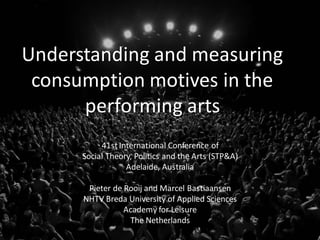
Understanding and measuring consumption motives in the performing arts (Pieter de Rooij)
- 1. Understanding and measuring consumption motives in the performing arts 41stInternational Conference of Social Theory, Politics and the Arts (STP&A) Adelaide, Australia Pieter de Rooij and Marcel Bastiaansen NHTV Breda University of Applied Sciences Academy for Leisure The Netherlands
- 2. Introduction motivation • mental disposition to aim at specific behaviour or a trigger to act • Understanding motivation important for: – understanding satisfaction, experiences and decision-making process (Crompton and Mc Kay, 1997;Snepinger et al., 2006;Hume et al., 2006) – designing offerings • no common understanding on categorizing, conceptualizing and measuring consumptionmotives in the performing arts • current literature it is fragmented and incomplete (Swanson et al., 2008)
- 3. Objective & research questions Objective: to understand and measure consumption motives in the performing arts and to explore the importance of these motives to performing arts visitors. Research questions: 1. How can we conceptualize and categorize consumption motives of performing arts visitors? 2. How can we measure these consumptionmotives?
- 4. Qualitative study • In-depth interviews • Quota sample of 47 respondents Dutch theatre (Theaters Tilburg): reflecting number of attendances, postal code areas, gender, genre and age • Data-analysis: transcription, indexing, framework (Ritchie and Lewis, 2003)
- 5. Qualitative study Interviews: • What does respondent expect and want to experience? • Association technique was applied, presenting eight cards describing eight consumption motives: ‘I want to see or hear something beautiful’ (aesthetics) ‘I want to learn something or to amass knowledge’ (cognitive stimulation) ‘I want to get away for a short while and recover my energy’ (reduction) ‘I want to get totally absorbed or be entranced’ (transcendence) ‘I want to have pleasure and be entertained’ (entertainment) ‘I want to experience new and original things’ (variety and novelty) ‘I want to be with other people’ (bonding) ‘I want to belong to the people who visit a theatre’ (distinction)
- 6. Results qualitative study • each individual interrelates the motives in his/her own way and from their own perspective • The main reasons to attend are individual combinations of motives, different in time, and vary with companions and the type of performance • This study not only shows that there are many connections between motives, but it also shows that certain definitions have overlapping elements
- 8. ‘We have 8 grandchildren so, we never go all together, but always the two of us, with two grandchildren. This is what we do and we want to continue to do it. We think it’s a small stimulus to develop an interest in culture’. ‘ And also because of the shrewdness of the cabaret performer. What’s his view of society is. And also the mirror he holds up to life.’ ‘ Yes, I feel it’s just a nice outing. Not too long, not too short. Just something different. Just to be entertained.’ 'And it’s logical that you want to see something wonderful, otherwise you wouldn’t go. That definitely has to be so.'
- 9. ‘A girlfriend of mine sings in a church and sometimes they give performances. And my daughter who plays at M4U, so I go there as well. And a niece who plays at Factorium.’ ‘Yeah, they are after all a bit like yourself, I think. A little, not too alternative and not too common.’ ‘So that really with your friends, acquaintances and family, you also really undertake something. Obviously they pop in sometimes for a coffee or suchlike, but this is really doing something together.’ ‘ I think it’s good that this often happens. That people think: I want to go with that group of people, then I can talk about it and then I can also say at parties that I’ve been somewhere.’
- 10. Quantitative study • Goal: to test the model and to develop an instrument to measure consumptionmotives • cross-sectionalstudy among guests of concerthall ‘De Doelen’ in Rotterdam, The Netherlands • online questionnaire sent to 714 visitors of a classical music concert (Mozart) four days before the actual concert took place • 220 visitors completed the questionnaire (30.8% response rate)
- 11. Questionnaire construction • items taken from questionnaires used in previously published studies in arts, tourism and sports (Crompton and McKay, 1997; Fodness, 1994; Funk et al., 2003; Glynn et al., 1996; Kyle et al., 2006; Swanson et al., 2008). • Where necessary: adaptation to performing arts context • based on the qualitative study, a quantitative pilot study and a discussion with marketing management of concerthall ‘De Doelen’, a total of 17 items were constructedby the authors themselves.
- 15. - Most of the motives: high component loadings (Cultural Reduction, Cultural Stimulation, and all four social motives). - Items Cultural Transmission did not cluster together into one single component
- 16. - Six items Cultural Aesthetics on two different components (first four items Artistic Value; last two items Enjoyment of Beauty of the performance) - Cultural Reduction measured by two dimensions (escape and recreation): both dimensions clearly cluster together in one component.
- 17. relatively good fit: X²(8)=8,448, p>0,05, X²/df=1,056, GFI=0.998, RMSEA=0.007, CFI=1.000.
- 18. Conclusion • Motives: cultural and social nature • Cultural aesthetics in the heart of framework • Framework largely confirmed in quantitative study • Need for replication with different audiences from different venues
